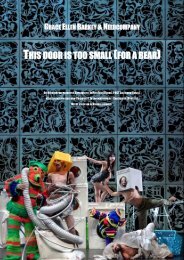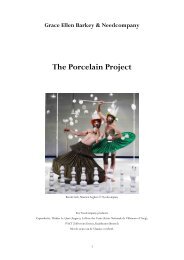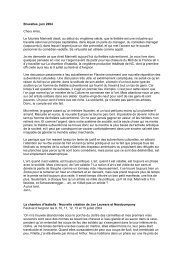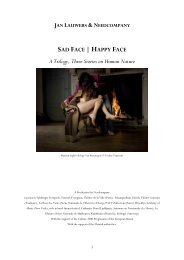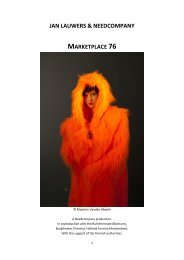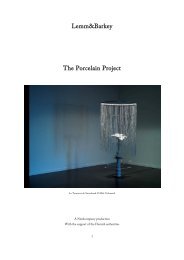THE ART OF ENTERTAINMENT - Needcompany
THE ART OF ENTERTAINMENT - Needcompany
THE ART OF ENTERTAINMENT - Needcompany
Create successful ePaper yourself
Turn your PDF publications into a flip-book with our unique Google optimized e-Paper software.
same way that rituals facilitated contact with the gods, media make our inner and outer world<br />
experimentable and communicable. They infiltrate into the pores of the bodies of individuals. The media<br />
control, direct our attention and channel collective behaviours,” added Henk Oosterling. The medium has<br />
become the means of subsistence. In other words: Does life exist outside the Matrix? Can we still think<br />
outside the ‘formats’? Has the world become irremediably ob-scene?<br />
7. The Duchamp Fountain 2<br />
Two decades after Duchamps’ Fountain, Walt Disney’s Snow White and the Seven Dwarfs (1937), the first<br />
full-length animated film appeared. Lauwers considers Duchamp and Disney as two icons of the visual<br />
culture of the twentieth century. D&D represent two radically opposed gestures. The fundamental gesture<br />
of Duchamp is destruction, demolishing the existing order. The fundamental gesture of Disney is creating a<br />
new mythology and new iconography. It is true that Disney does not form part of the history of art in the<br />
strictest sense of the word, but his impact – and this applies to his impact on artists too – is greater than<br />
that of Duchamp. For Lauwers D&D represent a tension in modern art: the longing for iconoclasm and<br />
idiosyncrasy mixed with the desire for iconography and communication. He translated this tension into two<br />
dramatic trilogies: the Snakesong Trilogy and Sad Face | Happy Face. Is the transgression from Snakesong<br />
Trilogy to Sad Face | Happy Face a transgression from Duchamp to Disney, from modern iconoclasm to a<br />
post-modern mythology, even if it is fragmented and hybrid? For the American art historian, Wendy Steiner<br />
the 20th century is the century of ‘autonomous’ art that she calls ‘sublime’. The 21st century however, will<br />
in her opinion, be the century of heteronomous art that she associates with what is ‘beautiful’. She believes<br />
that sublime represents art that tears apart, that is disturbing and alienating, that does not seek<br />
recognition from a certain audience or a certain community, while beautiful represents communication,<br />
consolation, openness and dialogue with the public. Steiner’s vision is too simple, but it reveals a part of<br />
the crisis that is having an impact on the notion of autonomy. Isabella’s room, the first part of Sad Face |<br />
Happy Face, was born out of the desire to create a much more direct communication with the audience,<br />
while accepting that modern art since Duchamps’ Fountain, had lost a lot of its contact with the public:<br />
“Was the removal of emotion from works of art that we have seen since Fountain a good move? That is the<br />
fundamental question I ask myself. Duchamp changed the function of the object and demanded that the<br />
audience think about it. Anyone who is not familiar with the framework of reference in which Fountain is<br />
placed, does not understand the image. My opinion now is that a work of art should be able to hold its own<br />
even without a context. The work of art should have the same effect as the pyramids in Egypt: even the<br />
greatest nitwit realises immediately that something happened there. The reflection that Duchamp<br />
provoked, is important and necessary, but I think that the point of view of the person observing has been<br />
forgotten. By specialising you can lose your relationship with society. Duchamp forced the audience to<br />
specialise in art, if they wanted to be able to understand it. Gilbert and George have also recently admitted<br />
that the greatest error in modern art has been to have not given the observer a chance. This ivory tower<br />
mechanism has brought in its wake the elimination of the social aspect of the visual arts and its adoption by<br />
the commercial circuit. Because of the tragedy of applause, Marcel Duchamp’s Fountain has returned to its<br />
status as a urinal. Because images no longer exist without ‘reflection’, the entertainment industry has<br />
chosen to exclude the concept of reflection and has consecrated applause. That is tragic. Artists are also<br />
responsible for this. An enormous confusion has emerged around art, culture and leisure. Artists have<br />
forgotten their role. Artists such as Luciano Fabro and Michelangelo Pistoletto say that artists must search<br />
for wisdom, not truth, but wisdom. Art is about asking questions and not providing answers. But then you<br />
have to be asking the right questions. At the current time a lot is demanded of art and artists. In recent<br />
years long and intense discussions have been held about canon and repertoire, about making the public<br />
10




